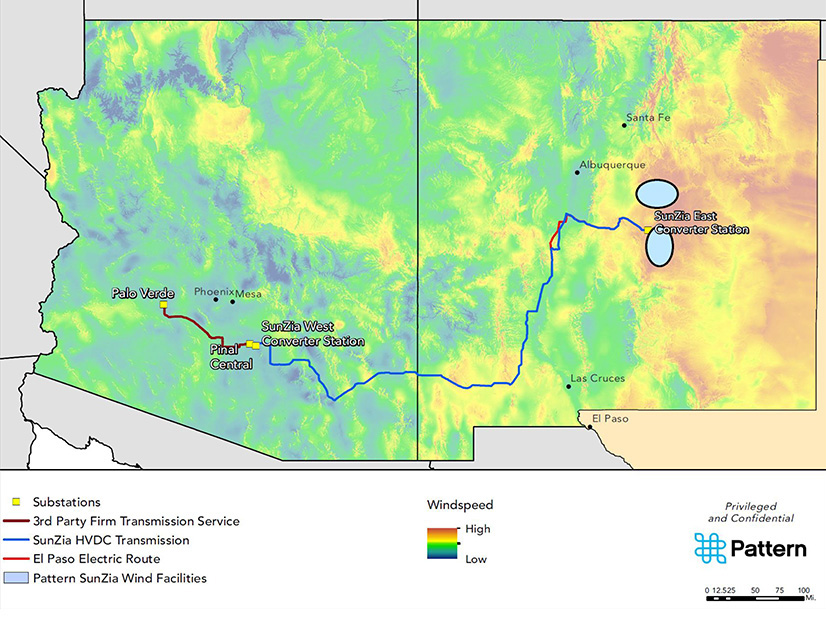
Arizona regulators have granted a key approval to the SunZia Transmission project, Pattern Energy’s proposal for delivering wind energy from central New Mexico into Arizona.
The Arizona Corporation Commission (ACC) last week approved a certificate of environmental compatibility for the project, which will consist of two 525 kV transmission lines across a 550-mile corridor.
The lines are intended to send energy from the 3,500 MW SunZia Wind project, which Pattern Energy is looking to develop in central New Mexico, to population centers in Arizona. SunZia Wind will be the largest wind project in the Western Hemisphere, the company said in a release.
“SunZia is proof that New Mexico is leading the charge in the clean energy transition,” U.S. Sen. Martin Heinrich (D-NM) said in a statement.
The ACC approval completes the Arizona state permitting process for the transmission project. In addition, the New Mexico Public Regulation Commission granted two separate approvals — in May and in October — related to SunZia Wind, Pattern Energy said.
The company said it is awaiting approval from federal agencies, including the Bureau of Land Management, as well as local jurisdictions. Construction is expected to start in mid-2023.
Amendments Requested
The ACC originally approved an environmental certificate for SunZia Transmission in 2016. In May, SunZia Transmission LLC asked the commission to amend the approval. SunZia asked the commission to split its decision into two separate environmental certificates to allow separate ownership of each line. The move will facilitate financing.
SunZia also asked the commission to approve additional structure types and updated structure design for the project. In addition, the company asked to extend the time to complete the project, from February 2026 to February 2028.
Pattern Energy called the commission’s unanimous decision to approve the requests a “major milestone.”
Critics of the project said it would harm wildlife and questioned the benefit to Arizona, because New Mexico power would be sold to California, according to a draft order to approve the certificate.
A Pattern Energy spokesman said agreements are still being negotiated, so it’s too early to say how much of SunZia’s wind energy would go to California.
Regarding wildlife, Pattern Energy said previously that SunZia Transmission worked closely with wildlife conservation groups to analyze environmental impacts and find the best route for the transmission project.
Supporters of the transmission project pointed to the need for more renewable energy to combat climate change and the economic benefits the project would bring to rural Arizona.
“Our window to combat [climate change] by reducing greenhouse gas emissions is closing quickly,” Adam Stafford, Western Resource Advocates’ managing senior staff attorney in Arizona, said in a statement. “We need to take action now, and building the SunZia lines helps us move in the right direction.”
Kevin Wetzel, Pattern Energy’s senior director of business development, said the SunZia projects would “greatly benefit” Arizona. SunZia wind will complement solar energy produced in the state, he said, helping utilities and commercial customers reach their renewable energy goals.
In addition, “new transmission and diversified generation resources will improve overall WECC reliability and resiliency, which benefits all Western states, including Arizona,” Wetzel said in a statement provided to RTO Insider.
Project Acquisition
In July, Pattern Energy announced it had acquired SunZia Transmission from SouthWestern Power Group. Pattern Energy had previously been awarded the full 3,000 MW of capacity of the transmission line.
SouthWestern Power Group is retaining ownership of a second 500 kV transmission line, El Rio Sol Transmission.
Combined, the SunZia transmission and wind projects form the largest renewable energy infrastructure project in U.S. history, with a total investment of more than $8 billion. Both projects are privately funded.
After initial approval of SunZia Transmission, the route was adjusted in consultation with the Department of Defense and White Sands Missile Range. The modified route partially parallels the existing Western Spirit Transmission line for 35 miles, which reduces environmental impacts, Pattern Energy said.


